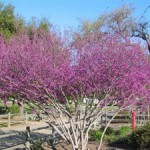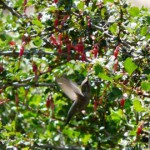Oak woodlands are found throughout the chaparral regions of California and northwestern Baja California. Oak woodlands are different from forests: their overstory is discontinuous, leaving many gaps in the canopy. This creates a habitat of both sun and partial shade for the species that dwell and grow in this area.
 Common Name: Western Redbud
Common Name: Western Redbud
Latin name: Cercis occidentalis
Native Habitat: Inner North Coast and Klamath ranges; Sierra Nevada, Cascade and Peninsular ranges, and east to Texas
Soil: Well drained
Water: Drought tolerant to occasional
Light: Sun to partial shade
Height X Width: Maximum 20 feet x 30 feet. Usual: 20 feet x 20 feet.
Leaves or Stems: Glossy blue-green, heart-shaped, winter-deciduous.
The Western Redbud has reddish-purple seed pods that hang on the tree in winter. It prefers full sun, some summer water for faster growth and regular water in desert areas. It’s tolerant of clay soils and needs a winter chill before flowers set properly. Flowers and young pods are edible.
 Common Name: Fuchsia Flowered Gooseberry
Common Name: Fuchsia Flowered Gooseberry
Latin Name: Ribes speciosum
Native Habitat: From Baja California North to Santa Clara.
Soil Composition: Dry, sandy, well drained soil.
Water: Once to twice a month, or none, depending on the season
Light: Full to partial shade.
Height x Width: 4-10 feet tall and 7 feet wide.
The Fuchsia Flowered Gooseberry has fuchsia flowers during the spring season. The trumpet-shaped flowers attract hummingbirds. The plant has spiny stems and small red fruit. During the summer it may or may not be deciduous, depending on the level of drought stress it is under. Though it can tolerate this, it looks nicer if it is given a bit of extra water during this period of time.